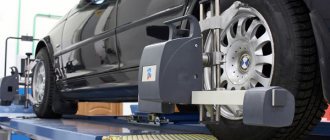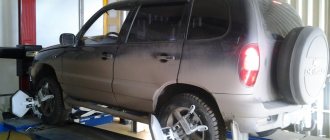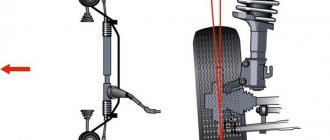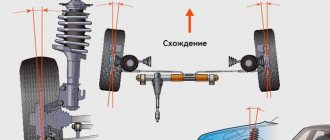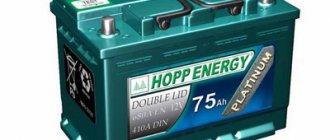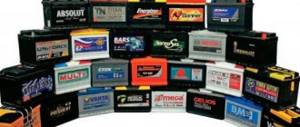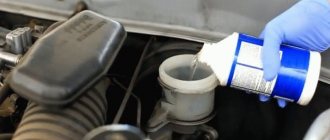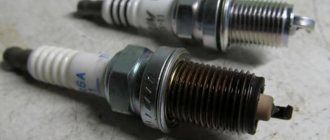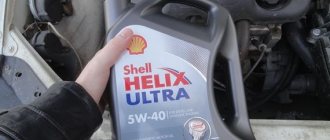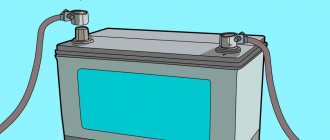In our workshop, measuring and adjusting take about 40 minutes on average. However, there are a huge number of nuances that can either speed up this process or slow it down for quite a long time.
The measurement time is greatly reduced by the use of modern 3D wheel alignment stands, where the procedure for compensating wheel rim runout is performed by rolling the car back and forth, and not as in earlier models, when it was necessary to lift the car and compensate for each wheel separately.
Any connection that is corroded can not only slow down the adjustment procedure, but also delay it indefinitely. For example, tightly soured adjusting bolts in silent blocks that cannot be heated with gas, because this will lead to destruction of the rubber-metal hinge.
Below we will try to create a small diagram to roughly show how long it takes to do a wheel alignment.
| 15 minutes. Measuring wheel alignment angles, which includes actually driving the car into the workshop, inspecting the suspension, equalizing tire pressure and other preparatory work. |
| 30 minutes. Measuring the wheel alignment and adjusting the front toe-in when the locknuts on the tie rods are not too soured. |
| 45 minutes. Measuring wheel alignment and adjusting on the front and rear axles, provided that everything is loosened well. |
| 60 minutes or longer. Everything unscrews very poorly, but eventually it unscrews. True, using a gas burner and a meter wrench. Or the car has a complex suspension with a large number of adjustments. |
If you take care of your car's suspension and go for a wheel alignment after a chassis repair, then most likely it will take no more than 30-40 minutes. Otherwise, it is advisable to have at least an hour and a half of free time, since any rush during measurement and adjustment is extremely contraindicated.
Why will you have to do a wheel alignment of your car after spring?
Have you read the news that soon many premium tires will rise in price by 15-20%? If you're not aware of this important change, be sure to check it out here.
Meanwhile, we wondered if we could somehow help motorists save on one of the most important safety elements - tires? Having read a lot of forums and familiarized ourselves with the opinions of auto experts, we seem to understand what needs to be done to certainly extend the life of car tires.
It turns out that only one rule applies here - preventive measures for setting the angle of alignment and toe of the wheels, as well as castor on those cars where it is adjustable (caster is the angle at which the wheel's turning axis is tilted).
In other words, if you want to keep the tread of your tires in good condition for as long as possible (meaning uniform wear), then you just need to make it a rule to go to a service center where they do wheel alignment at least once a year.
If the steering wheel moves to the side during an impact, this immediately indicates a wheel alignment failure.
Moreover, according to Alexander Andreadi (one of the creators of the Meteor-24 network of tire workshops), a full interview with which can be found on the drive2.ru website by clicking on the link here, even falling into a single hole can lead to the need to visit the workshop , because the fine settings of the suspension will most likely be lost:
Yes, that's exactly how it happens. Can not argue. If you have ever driven into a large hole at speed, especially if the hole in the asphalt was on the side of the loaded wheels, and then began to slowly “devour” the tires, you will agree with the expert’s opinion. After visiting the service station, they will actually show you the downgraded indicators at the stand.
Wheel alignment 3D Hunter SEAD, Lefortovo
The new computer wheel alignment stand Hunter 3D, installed in the car service since December 2014, allows us to carry out work on wheel alignment adjustments for all cars, including cars of the premium brands Ferrari, Lamborghini, Bentley, Bugatti, Porsche with wheel diameters up to 24 inches inclusive. Our technicians are professionals, have extensive experience working on the new Hunter 3D computer wheel alignment stand at one of the official dealers (BMW, GM, Audi) and have completed training courses from the official Hunter equipment supplier.
- Age of equipment. Over time, the accuracy of the equipment decreases. Wear and tear occur, and damage occurs. The wheel alignment stand installed in December 2014 is the newest 3D wheel alignment stand in the South-East Administrative District, and as of December 15, 2014, the newest in Moscow. Taking into account the growth of the dollar (the machine is produced only in the USA), the cost of the equipment has already almost doubled...
- Adjusting the camber stand. The wheel alignment machine must be adjusted and tuned annually. Otherwise, what looks like a correctly set angle on a computer screen and is highlighted in green may not be so in practice. In our case, our Hunter 3D wheel alignment machine was adjusted less than a month ago.
- Service cost. For the entire 2020, we have set an anti-crisis price for our clients! How much does it cost to do a wheel alignment? Details in the price section.
- Which wheel alignment is better? Where is the best place to get a wheel alignment done? Is it possible to do a wheel alignment at home? Is self-alignment a reality? What is better: beam alignment or laser alignment? How to do a wheel alignment yourself? All these questions can be answered briefly and succinctly: Modern 3D equipment in combination with the experienced skillful hands of a car suspension professional, access to an online database of wheel alignment angles in combination with a working suspension give an excellent result! Whether you are doing a wheel alignment on a Ford, Mercedes, Audi, BMW, Porsche, Maybach or Maserati - in the hands of our professionals, your car will acquire new stability on the road!
- How long does the procedure take for wheel alignment? - about 30 minutes, depending on how long it takes to diagnose the suspension (30 minutes is the standard for diagnosing a fully serviceable suspension), how easily the adjustment nuts will be unscrewed. There are, of course, exceptions. The longest wheel alignment work in our memory was carried out on a Mini car with a non-standard lowered suspension, with “non-original” offset wheels on low-profile tires.
In principle, a high-level master is able to properly adjust the wheel alignment angles on any equipment, as long as it is in good working order and properly calibrated. The only question is how long it will take him to do this (especially to align the steering wheel). In addition, the more powerful the stand’s software, the more deeply and accurately it allows one to diagnose the state of the “geometry” of the vehicle’s chassis using broader parameters in some non-standard (atypical) situations. If the master has insufficient theoretical and practical training and does not care about his work, then no amount of coolness and sophisticated equipment will save him. Therefore, it is better to go to proven places for wheel alignment (about which there are many positive reviews). The most ideal option is a combination of a master’s extensive experience and the availability of powerful equipment, since it allows him to fully reveal his potential.
5. Differences in the characteristics of the front wheels (wear, elasticity, force heterogeneity of the frame) This factor often manifests itself when replacing wheels (for example, after a seasonal “change of shoes”). Moreover, the “wheel alignment” remains unchanged, but only a certain tilt of the steering wheel appears in one direction or another.
On bad roads, adjust your wheel alignment more often
Thus, the following important conclusion can be drawn: if bad roads prevail where you live, check your alignment/camber twice a year. The standard scheme, which one could often hear about in garages, about wheel alignment says: do this after “changing” the car for summer tires and vice versa.
Add to this the possibility of falling into a large hole at speed. This happens infrequently, perhaps once a year, or even less often (it all depends on the speeds at which you travel), but as soon as this happens, do not be lazy to go to a car service center to diagnose the suspension, check the tires for the presence of a hernia (it may be on the back side of the tire bead) and checking the alignment and camber.
But! Even if the roads in your region are ok, you should also not neglect the golden rule of checking the suspension alignment twice a year. The thing is that in the spring potholes appear on all roads in the country. Somewhere more, somewhere less, but they are there, which means that when riding on bumpy roads, you loosen the suspension one way or another. By summer the holes will be patched, but no one will take care of your car except you.
This leads to the second most important nuance:
The main rules to understand when wheel alignment is required
- When you buy a car, the mechanics at the service station inside the store are required to perform a wheel alignment, but in reality this is not always the case. Often this type of procedure is performed in separate salons, because of this, people sometimes turn to other service stations. It is better to find out about this point in advance, perhaps it is even better to come to the salon, precisely in order to gain control over this process.
- When tires are changed on wheels, it is recommended to check the alignment. But here it’s worth understanding that checking and doing are two different things, because a car can be in excellent condition.
- If you understand from your driving style that one of the wheels is pulling to the side, then you need to check the wheel design. This is the most forced measure, which obviously requires wheel alignment. You should also check yourself to see how the steering wheel works without holding it. This way you will understand which direction your car is being driven.
- When it is necessary to do a wheel alignment, it is also clear when the tires on the car are worn out. If you feel that a replacement is about to be needed, then this parameter of the car needs to be checked.
- Let's say you still have a maintenance guarantee, then you must be informed about the timing of the wheel alignment check. As a rule, the mileage will be from 15 to 20 thousand km.
A clear example of how alignment affects the position of the wheels on a car
Let's look at another interesting example, which concerns the care of car tires. A fairly detailed foreign video will help us study the material. Don't worry, we'll give you a translation of the main points:
The 1st minute of the video shows and describes how wheel camber affects the handling of a car. In this case, negative. Typically used by sports car manufacturers, it makes it easier for them to turn into corners at high speeds by actively resisting tire deformation and increasing friction.
More “civilian” camber options are more concerned about the safety of tires and rolling.
The 2nd minute of the video visualizes the so-called castor - the angle of longitudinal inclination of the steering axis of the car wheel. In other words, this is wheel runout, exactly the same as on bicycles or motorcycles. They simply see this better using the example of a fork.
The castor setting is a sports setting and is not used on regular cars.
The 3rd minute of the video shows the wheel alignment. The smaller the toe-in, the less tire wear. However, when driving, the driver involuntarily makes small movements with the steering wheel. These mini-steers should not affect straight-line movement, which the toe-in handles perfectly.
What is “wheel alignment”
Camber Wheel camber is the angle between the central plane of the wheel and the perpendicular to the road surface. Correct camber ensures good vehicle control and traction. If the camber is not done correctly, this can lead to uneven tire wear and handling problems. Toe-in The most critical wheel alignment angle is the toe-in angle. If the toe angle is too positive or negative, this leads to rapid tire wear. Toe is the difference in distances measured at the front and rear points of the wheel rims in the horizontal plane. If the distance measured at the front points is less than the distance measured at the rear points, then we speak of positive toe-in; if, on the contrary, we speak of negative or reverse toe-in. Toe is considered zero if the wheels are parallel to each other.
How often to do a wheel alignment
Typically, car services recommend doing wheel alignments at intervals of 10-15 thousand km on domestic cars and up to 30-50 thousand km on foreign cars. It is advisable to check the wheel alignment and, if necessary, adjust it once a year, for example in the spring. An unscheduled check and adjustment of the wheel alignment angles will be needed in the following cases:
- The chassis was repaired, for example: replacing steering tips, replacing steering rods, replacing suspension arms, replacing silent blocks, replacing shock absorbers; When changing the car's ground clearance, for example, installing inserts (“houses”), installing shortened springs; If you install any heavy equipment on your machine weighing 30 kg on the rear axle or 100 kg on the front; The car began to pull to the side; There was severe wear on the tires; The steering wheel self-returns poorly when exiting corners.
After what work is it not necessary to do a wheel alignment?
Wheel alignment is not a cheap procedure, and often unscrupulous services assure drivers that after carrying out this or that work, it must be done. Below are the most common situations where a driver may feel like they need to perform a wheel alignment, but in reality they don't.
Tire replacement
The most common misconception is that when replacing winter tires with summer tires and vice versa, a wheel alignment is required. This is not so, since replacing tires performed in a standard manner does not affect the toe-in and divergence parameters of the wheels. If, after replacing the tires, the car begins to pull spontaneously to the side when driving in a straight line, you should first check the tires for even wear.
Replacing shock absorbers
We recommend reading: How to bleed shock absorbers before installation
After replacing the shock absorbers, there is no need to perform a wheel alignment, since the steering rods and ball joints practically do not depend on them. When replacing shock absorbers, these steering elements are not affected; they do not even need to be unscrewed.
Replacing stabilizers
The situation with stabilizers is identical to shock absorbers. After replacing them, there is no need to perform a wheel alignment, since the work does not affect the key elements of the suspension and steering.
( 411 votes, average: 4.54 out of 5)
Instructions: How to flush the engine cooling system with your own hands
How to check and replace engine mounts
